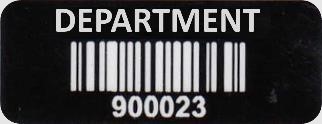Do barcodes have to be on a white background?
Customer asked a Question
Do bar codes have to be on a white background? What is the closest you can print to a
bar
code? Is there
a typical exclusion zone?
We are thinking of including the product barcode as part of the packaging. So a product
could
have a related image either side of the bar code. To work the bar code would have to
sit on the background color of the label as well.
Does this sound feasible to you?
Answer
A: The short answer is that technically this would be out of spec, but in the real world it can work, with some caveats. Let's take it one step at a time.
Q: Do bar codes have to be on a white background?
A: According to the technical specs, yes. But let's get some context. As with any technology, when barcodes were first introduced, there was not a lot of scope for error. To achieve a decent read rate, everything had to be to spec, which means a white background, with black lines, and not just any black, but a tightly controlled spec. But engineers being engineers, and capitalism and competition being what it is, the manufacturers of barcode readers have been constantly improving the technology, so that now most readers can read barcodes which are way out of spec. Or even barcodes read through a transparent wrapping. And so most modern day readers can read a barcode with colors other than black on white, providing that there is sufficient contrast. You are operating out of spec, but most times it will work.
Things to be avoid include a patterned background, and some shades of red. Best advice is to mock up some barcodes in the target colors and test them on a variety of readers. But remember there is some small risk. And particularly avoid red. Readers come in two technologies, laser and imager. Lasers may not be so good with red stripes or red background.
Q: What is the closest you can print to a barcode? Is there a typical exclusion zone?
A: You are correct, an area free of lines is required at each end of the barcode,
usually
called the quiet zone
. At one time the quiet zone was typically a quarter of an
inch, the width of a pencil, but again, as the folk that design barcode readers have upped their
game,
the quiet zone has got thinner. No clear numbers, the real world answer is try it and
see... (and then add a bit for safety). And remember that results will vary from one model of
reader
to
another.
Q: We are thinking of including the product bar code as part of the packaging. So a product could have a related image either side of the bar code. To work the bar code would have to sit on the background color of the label as well.
A: No, sorry, but...
Having a design element at the side of the barcode is not going to work, but the good news is that you can put whatever you like on top of the barcode. And you can make the barcode as tall as you like, and have the top edge whatever pattern you like. So some stripes from the barcode can be extended upward (or downward) to make the pattern.
Q: To work the bar code would have to sit on the background color of the label as well.
A: Provided that there is adequate contrast between the stripes and the background, all will be well.
Q: Does this sound feasible to you?
A: So technically, you will be out of spec, and no manufacturer of barcode readers is going to give you a guarantee. But in the real world it will work, at some very small risk. Let us know if you need further details.


If you found this useful, you might also want to review:
- an introduction to barcode technology
 - 2D barcode labels
- 2D barcode labels- barcode label color and background
- premium asset tag
QAOK5329
